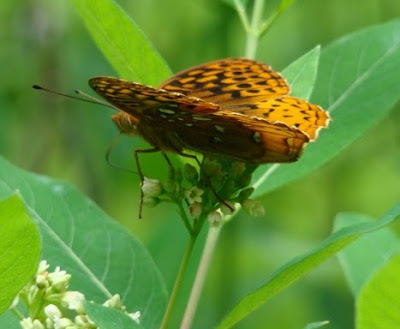
Great Spangled Fritillaries were the grand champions by sheer numbers, and this one was using his proboscis to probe for nectar in the blossom of Indian Hemp, Apocynum cannabinum a common member of the Dogbane family.

......................................photo by John Howard
We all stopped to admire the G.S. Frits on Purple Milkweed, Asclepias purpurascens. This uncommon milkweed is a real show stopper and John Howard captured the moment beautifully.
Boys will be boys, and when he is not taking photos, John loves poking around in every water-hole and catching every creepy crawly. And while the "boys" fussed around with their sedges and salamanders...
 some of us watched as a Tawny Emperor, a much less-common butterfly and a "lifer" for many in our group, spread its wings in the morning sun.
some of us watched as a Tawny Emperor, a much less-common butterfly and a "lifer" for many in our group, spread its wings in the morning sun. Tricia West (pictured above) and I worked a bit on our butterfly photography. I took the dorsal (top-side wings) view photo of the Tawny Emperor, and Trish got this diagnostic ventral photo of the male butterfly.
Tricia West (pictured above) and I worked a bit on our butterfly photography. I took the dorsal (top-side wings) view photo of the Tawny Emperor, and Trish got this diagnostic ventral photo of the male butterfly.Tawny Emperors are usually found mixed in with the common, and similar shaped Hackberry butterfly. Both species' caterpillars feed exclusively on Hackberry, one of our Ohio native trees.
...
Interested in attracting more butterflies to your yard? Consider planting a variety of butterfly host plants including a Hackberry, Celtis occidentalis tree. It could soon become an "arbor of eating" for Tawny Emperors,Hackberry and Snout caterpillars!



No comments:
Post a Comment